2006 FORD MONDEO fuel consumption
[x] Cancel search: fuel consumptionPage 80 of 198
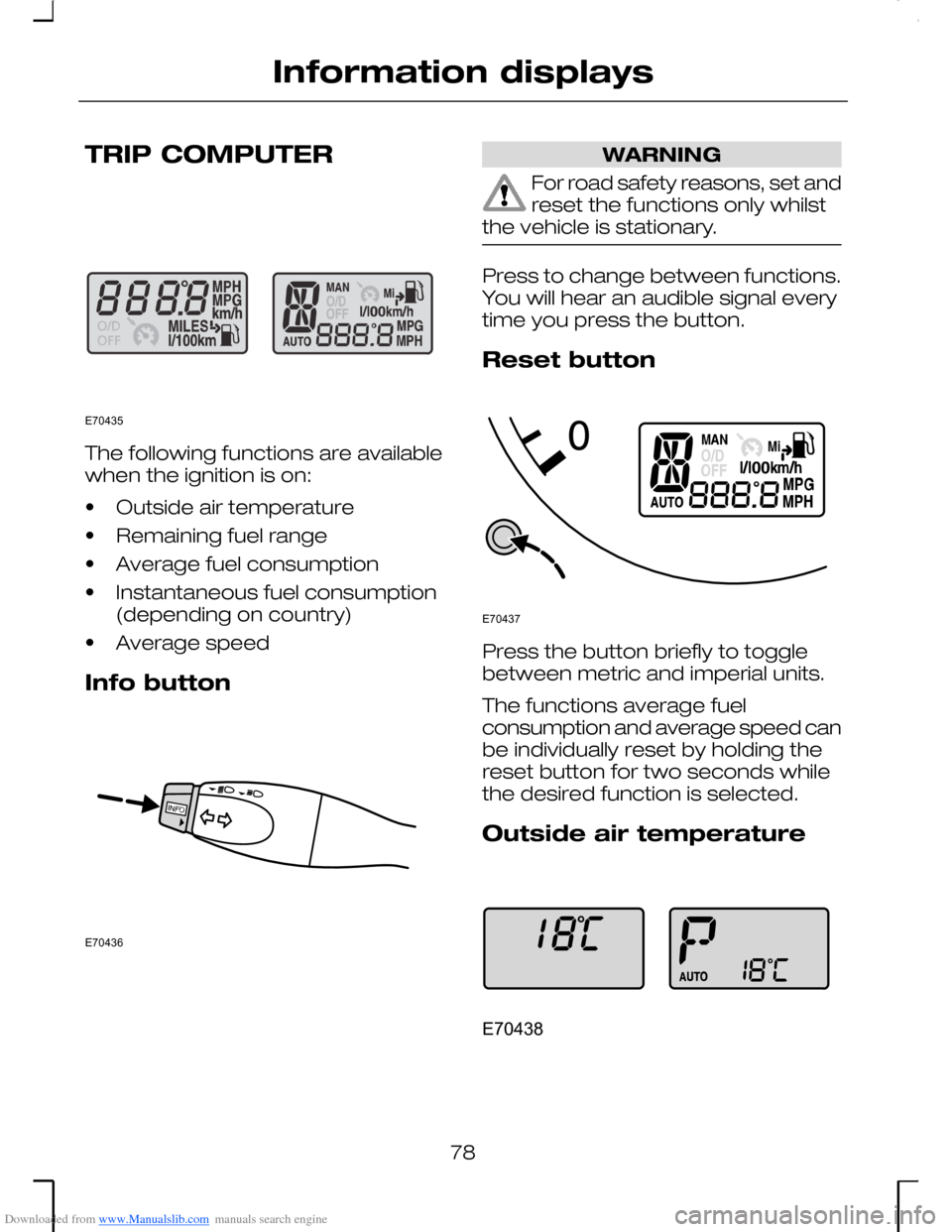
Downloaded from www.Manualslib.com manuals search engine TRIP COMPUTER
The following functions are availablewhen the ignition is on:
•Outside air temperature
•Remaining fuel range
•Average fuel consumption
•Instantaneous fuel consumption(depending on country)
•Average speed
Info button
WARNING
For road safety reasons, set andreset the functions only whilstthe vehicle is stationary.
Press to change between functions.You will hear an audible signal everytime you press the button.
Reset button
Press the button briefly to togglebetween metric and imperial units.
The functions average fuelconsumption and average speed canbe individually reset by holding thereset button for two seconds whilethe desired function is selected.
Outside air temperature
78
Information displaysE70435 E70436 E70437 E70438
Page 81 of 198
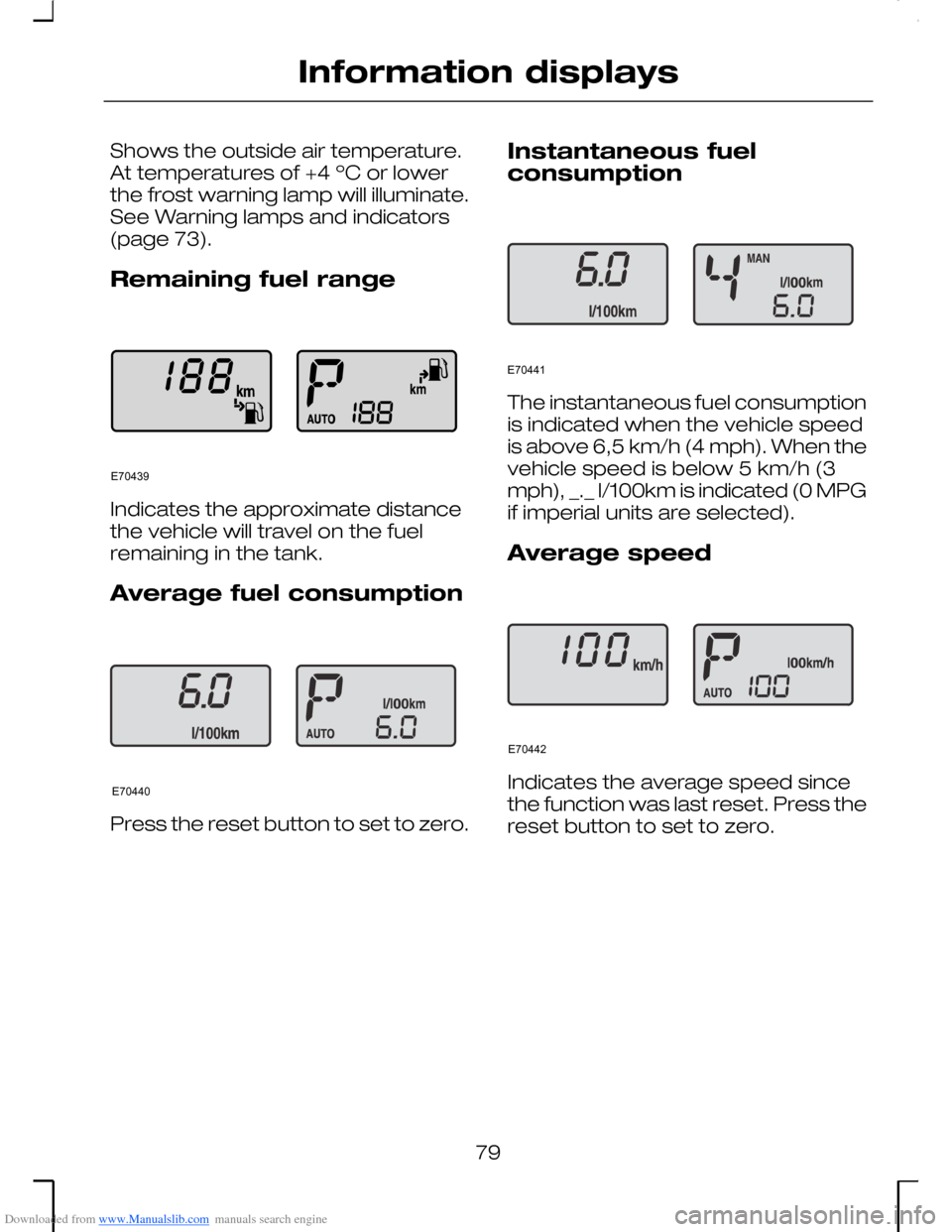
Downloaded from www.Manualslib.com manuals search engine Shows the outside air temperature.At temperatures of +4 ºC or lowerthe frost warning lamp will illuminate.See Warning lamps and indicators(page 73).
Remaining fuel range
Indicates the approximate distancethe vehicle will travel on the fuelremaining in the tank.
Average fuel consumption
Press the reset button to set to zero.
Instantaneous fuelconsumption
The instantaneous fuel consumptionis indicated when the vehicle speedis above 6,5 km/h (4 mph). When thevehicle speed is below 5 km/h (3mph), _._ l/100km is indicated (0 MPGif imperial units are selected).
Average speed
Indicates the average speed sincethe function was last reset. Press thereset button to set to zero.
79
Information displaysE70439 E70440 E70441 E70442
Page 82 of 198
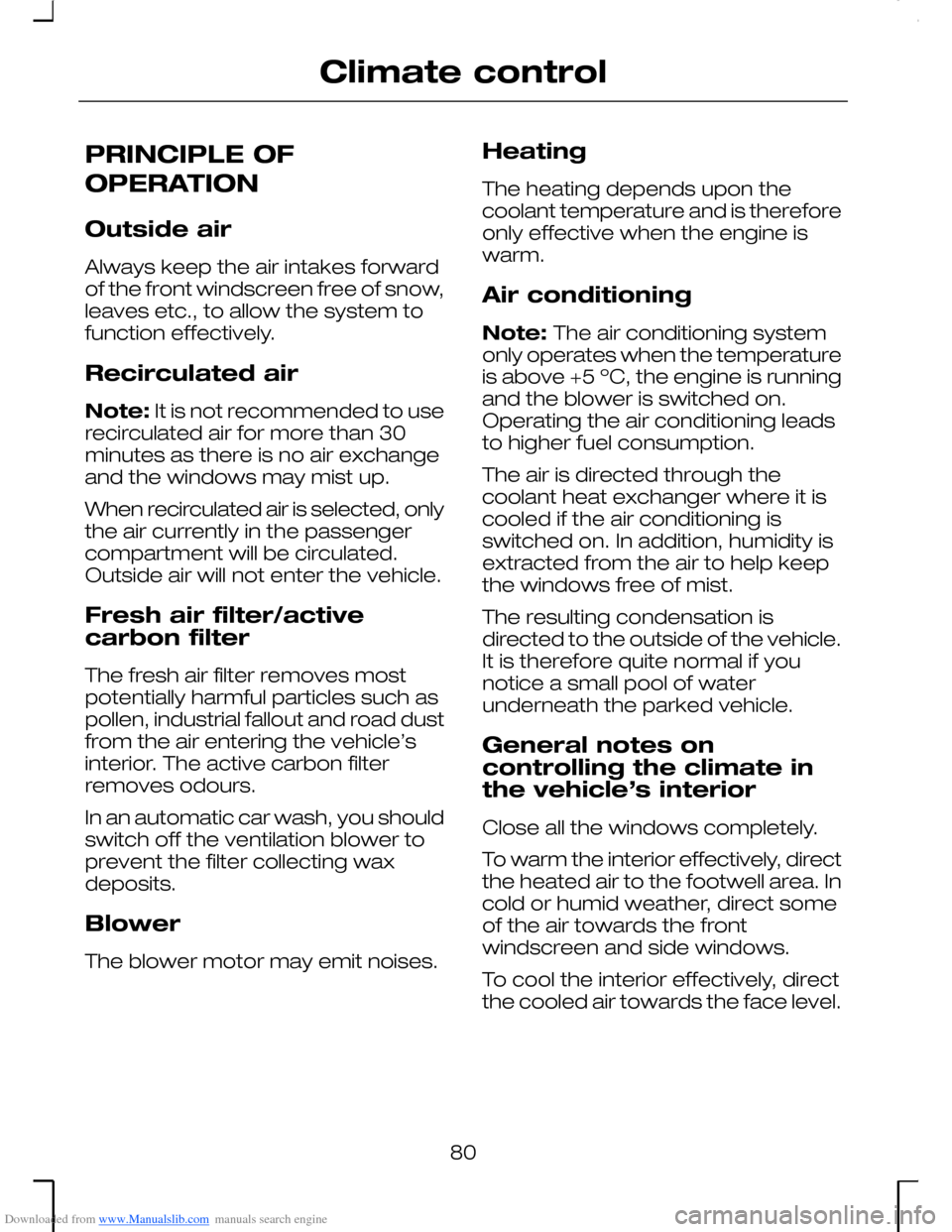
Downloaded from www.Manualslib.com manuals search engine PRINCIPLE OF
OPERATION
Outside air
Always keep the air intakes forwardof the front windscreen free of snow,leaves etc., to allow the system tofunction effectively.
Recirculated air
Note: It is not recommended to userecirculated air for more than 30minutes as there is no air exchangeand the windows may mist up.
When recirculated air is selected, onlythe air currently in the passengercompartment will be circulated.Outside air will not enter the vehicle.
Fresh air filter/activecarbon filter
The fresh air filter removes mostpotentially harmful particles such aspollen, industrial fallout and road dustfrom the air entering the vehicle’sinterior. The active carbon filterremoves odours.
In an automatic car wash, you shouldswitch off the ventilation blower toprevent the filter collecting waxdeposits.
Blower
The blower motor may emit noises.
Heating
The heating depends upon thecoolant temperature and is thereforeonly effective when the engine iswarm.
Air conditioning
Note: The air conditioning systemonly operates when the temperatureis above +5 ºC, the engine is runningand the blower is switched on.Operating the air conditioning leadsto higher fuel consumption.
The air is directed through thecoolant heat exchanger where it iscooled if the air conditioning isswitched on. In addition, humidity isextracted from the air to help keepthe windows free of mist.
The resulting condensation isdirected to the outside of the vehicle.It is therefore quite normal if younotice a small pool of waterunderneath the parked vehicle.
General notes oncontrolling the climate inthe vehicle’s interior
Close all the windows completely.
To warm the interior effectively, directthe heated air to the footwell area. Incold or humid weather, direct someof the air towards the frontwindscreen and side windows.
To cool the interior effectively, directthe cooled air towards the face level.
80
Climate control
Page 106 of 198
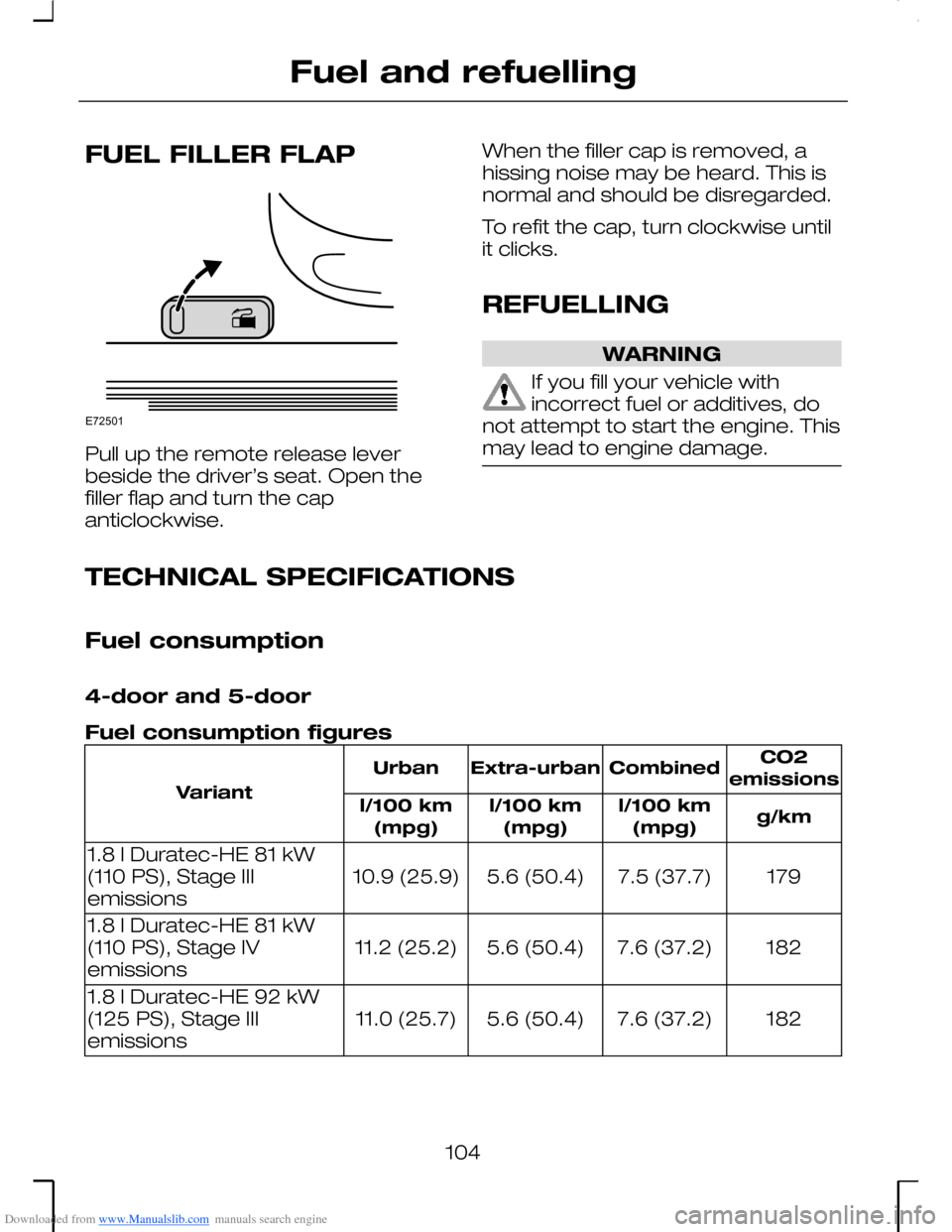
Downloaded from www.Manualslib.com manuals search engine FUEL FILLER FLAP
Pull up the remote release leverbeside the driver’s seat. Open thefiller flap and turn the capanticlockwise.
When the filler cap is removed, ahissing noise may be heard. This isnormal and should be disregarded.
To refit the cap, turn clockwise untilit clicks.
REFUELLING
WARNING
If you fill your vehicle withincorrect fuel or additives, donot attempt to start the engine. Thismay lead to engine damage.
TECHNICAL SPECIFICATIONS
Fuel consumption
4-door and 5-door
Fuel consumption figures
CO2emissionsCombinedExtra-urbanUrban
Variant
g/kml/100 km(mpg)l/100 km(mpg)l/100 km(mpg)
1797.5 (37.7)5.6 (50.4)10.9 (25.9)1.8 l Duratec-HE 81 kW(110 PS), Stage IIIemissions
1827.6 (37.2)5.6 (50.4)11.2 (25.2)1.8 l Duratec-HE 81 kW(110 PS), Stage IVemissions
1827.6 (37.2)5.6 (50.4)11.0 (25.7)1.8 l Duratec-HE 92 kW(125 PS), Stage IIIemissions
104
Fuel and refuellingE72501
Page 108 of 198

Downloaded from www.Manualslib.com manuals search engine CO2emissionsCombinedExtra-urbanUrban
Variant
g/kml/100 km(mpg)l/100 km(mpg)l/100 km(mpg)
1596.0 (47.1)4.8 (58.9)8.1 (34.9)2.0 l Duratorq-TDCi 85 kW(115 PS), Stage IVemission, 6-speed manual
1967.4 (38.2)5.8 (48.7)10.2 (27.7)2.0 l Duratorq-TDCi 85 kW(115 PS), Automatic
1545.8 (48.7)4.7 (60.1)7.7 (36.7)2.0 l Duratorq-TDCi 96 kW(130 PS), Stage IIIemissions, Manual
1596.0 (47.1)4.8 (58.9)8.1 (34.9)2.0 l Duratorq-TDCi 96 kW(130 PS), Stage IVemissions, Manual
1967.4 (38.2)5.8 (48.7)10.2 (27.7)2.0 l Duratorq-TDCi 96 kW(130 PS), Automatic
1616.1 (46.3)4.9 (57.6)8.2 (34.4)2.2 l Duratorq-TDCi
Estate
Fuel consumption figures
CO2emissionsCombinedExtra-urbanUrban
Variant
g/kml/100 km(mpg)l/100 km(mpg)l/100 km(mpg)
1847.7 (36.7)5.8 (48.7)11.1 (25.5)1.8 l Duratec-HE 81 kW(110 PS), Stage IIIemissions
1877.8 (36.2)5.8 (48.7)11.4 (24.8)1.8 l Duratec-HE 81 kW(110 PS), Stage IVemissions
1867.8 (36.2)5.8 (48.7)11.1 (25.5)1.8 l Duratec-HE 92 kW(125 PS), Stage IIIemissions
1897.9 (35.8)5.8 (48.7)11.4 (24.8)1.8 l Duratec-HE 92 kW(125 PS), Stage IVemissions
106
Fuel and refuelling
Page 194 of 198
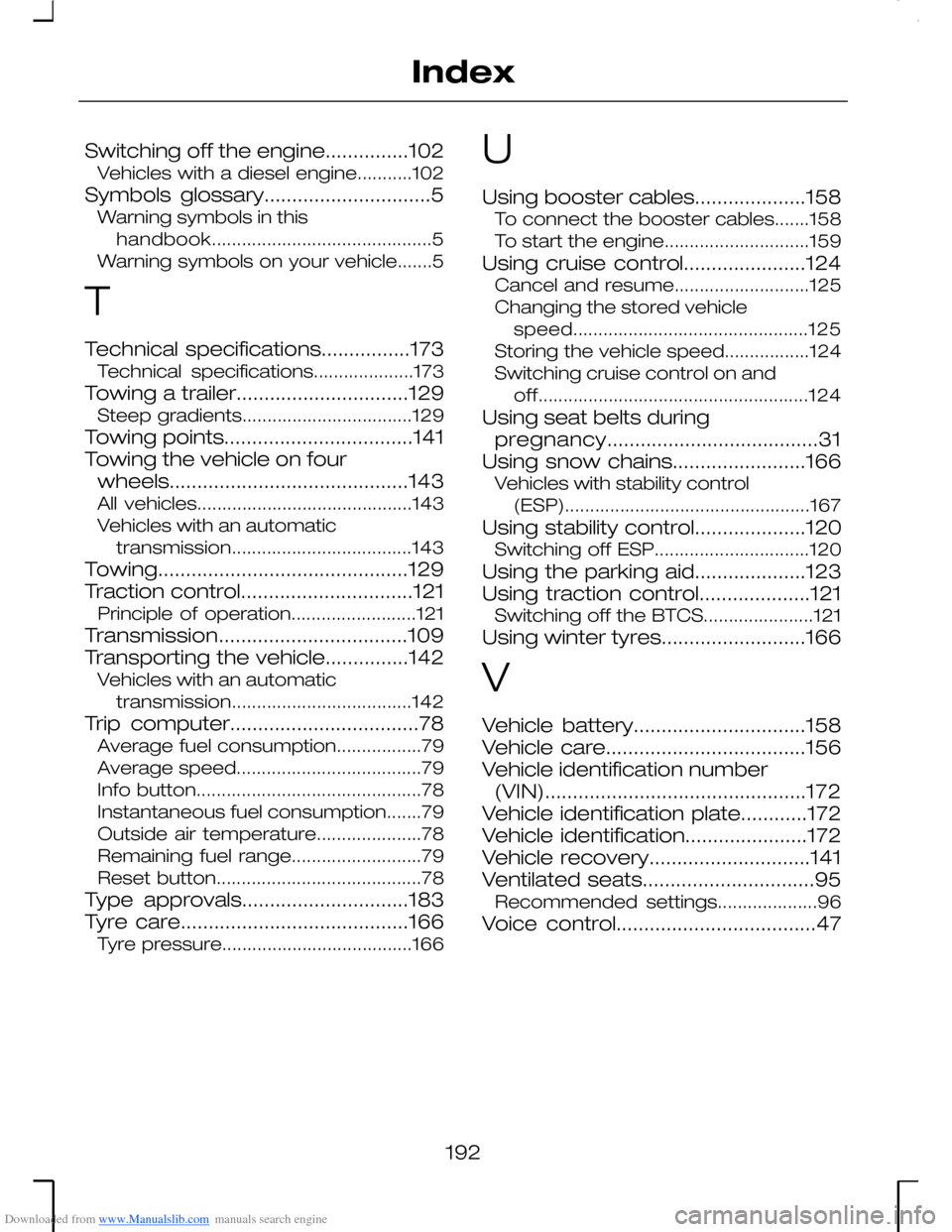
Downloaded from www.Manualslib.com manuals search engine Switching off the engine...............102Vehicles with a diesel engine...........102
Symbols glossary..............................5Warning symbols in thishandbook............................................5Warning symbols on your vehicle.......5
T
Technical specifications................173Technical specifications....................173
Towing a trailer...............................129Steep gradients..................................129
Towing points..................................141Towing the vehicle on fourwheels...........................................143All vehicles...........................................143Vehicles with an automatictransmission....................................143
Towing.............................................129Traction control...............................121Principle of operation.........................121
Transmission..................................109Transporting the vehicle...............142Vehicles with an automatictransmission....................................142
Trip computer..................................78Average fuel consumption.................79Average speed.....................................79Info button.............................................78Instantaneous fuel consumption.......79Outside air temperature.....................78Remaining fuel range..........................79Reset button.........................................78
Type approvals..............................183Tyre care.........................................166Tyre pressure......................................166
U
Using booster cables....................158To connect the booster cables.......158To start the engine.............................159
Using cruise control......................124Cancel and resume...........................125Changing the stored vehiclespeed...............................................125Storing the vehicle speed.................124Switching cruise control on andoff......................................................124
Using seat belts duringpregnancy......................................31Using snow chains........................166Vehicles with stability control(ESP).................................................167
Using stability control....................120Switching off ESP...............................120
Using the parking aid....................123Using traction control....................121Switching off the BTCS......................121
Using winter tyres..........................166
V
Vehicle battery...............................158Vehicle care....................................156Vehicle identification number(VIN)...............................................172Vehicle identification plate............172Vehicle identification......................172Vehicle recovery.............................141Ventilated seats...............................95Recommended settings....................96
Voice control....................................47
192
Index